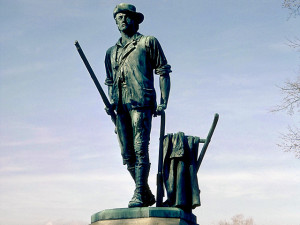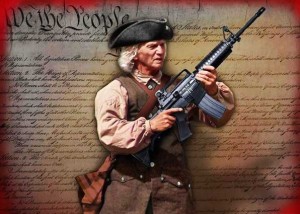 Let’s start out with the fact that a Militia can be organized or unorganized.
Let’s start out with the fact that a Militia can be organized or unorganized.
In colonial times, the first organized militia was deemed as the Continental Army, as established by a resolution of the Continental Congress on June 14, 1775. The Continental Army was created to coordinate the military efforts of the Thirteen Colonies in their revolt against the rule of Great Britain. Local militias and troops that remained under control of the individual states, or were otherwise independent, supplemented the Continental Army.
Before the forming of the Continental Army, each of the 13 colonies had their own militias. These militias, made up of part-time citizen-soldiers, were for local defense, or the raising of temporary “provincial regiments” during specific crises such as the French and Indian War of 1754-1763. Militias were comprised of young men and they were required to provide their own muskets, ball, and powder. The Intolerable Acts in 1774 began the formal training of militia men.
The Continental Army was the first “standing” army in the United States and the terms soldier and militiaman became an idealist method of distinguishing who was paid to fight and who was not. A soldier was considered as part of an army who was provided a weapon and then trained in its use while being paid to do so. The solder was also required to serve the United States for a certain period of time. Whereas, a militiaman was considered an individual and a volunteer who provided their own muskets, ball, powder, and provisions. Militia men were only required to support the Continental Army for short times.
The Militia men, unlike their solder counterparts, were the guerrilla-fighters of the day. They did not stand in long lines to face their enemy’s fire. Rather they fought behind rock, brush, and used the land and the element of surprise on their enemy. Many were experienced fighters after surviving the French and Indian wars that raged earlier in our nation’s history.
Without going into detail, which can be found in other places, the National Guard, the Army Reserves, and the Naval Militia became “selected” militias. The National Guard and Navy Militia took on the role as Homeland Security; whereas, the Army Reserve would supplement the Army in its role in overseas engagements.
Through the Selective Service and Training Act, passed in 1940, the young individual became a conscript of the United States when he reached a certain age and was accepted for service through a “draft” system. The draft was an effort to keep our military strong and originated in peacetime. Although there was a draft during the Civil War, the draft brought many men into the fighting during World War I; World War II; and the Cold War (including the Korean and Vietnam Wars). In 1973, the draft came to an end and service of our country has been on a volunteer basis ever since. However, registering for the draft is ongoing as a back-up to strengthening our military during a time of war. The argument for and against the draft sometimes gets very heated.
Today, the National Guard is considered by some as a “state-sponsored militia” by the virtue of federal and state funds that provide training and equipment for an organized militia. And, by being an organized militia, this satisfies the idea by some that the bearing of arms pertains strictly to the military.
One of the arguments regarding the 2nd Amendment of the United States Constitution is regarding the term “Militia” and its true meaning. By virtue of my age, I am no longer eligible to be part of the “Militia”, but that does not mean that I cannot be a “Militia.” Confused yet?
In order to get where I am headed in this little dissertation, I need to reference a couple of codes; 10 U.S. Code § 311 – Militia: composition and classes and 32 U.S. Code § 313 – Appointments and enlistments: age limitations.
10 U.S. Code § 311 – Militia: composition and classes
- The militia of the United States consists of all able-bodied males at least 17 years of age and, except as provided in section 313 of title 32, under 45 years of age who are, or who have made a declaration of intention to become, citizens of the United States and of female citizens of the United States who are members of the National Guard.
- The classes of the militia are—
- The organized militia, which consists of the National Guard and the Naval Militia; and
- The unorganized militia, which consists of the members of the militia who are not members of the National Guard or the Naval Militia.
32 U.S. Code § 313 – Appointments and enlistments: age limitations
- To be eligible for original enlistment in the National Guard, a person must be at least 17 years of age and under 45, or under 64 years of age and a former member of the Regular Army, Regular Navy, Regular Air Force, or Regular Marine Corps. To be eligible for reenlistment, a person must be under 64 years of age.
- To be eligible for appointment as an officer of the National Guard, a person must—
- Be a citizen of the United States; and
- Be at least 18 years of age and under 64.
In its original sense, militia meant “the state, quality, condition, or activity of being a fighter or warrior.” It can be thought of as “combatant activity”, “the fighter frame of mind”, “the militant mode”, “the soldierly status”, or “the warrior way”. In this latter usage, a militia is a body of private persons who respond to an emergency threat to public safety, usually one that requires an armed response, but which can also include ordinary law enforcement or disaster responses.
The act of bearing arms contextually changes the status of the person, from peaceful citizen, to warrior citizen. The militia is the sum total of persons undergoing this change of state. Persons have been said to engage in militia in response to a “call up” by any person aware of the emergent threat requiring the response, and thence to be in “called up” status until the emergency is past.
There is no minimum size to militia, and a solitary act of defense, including self-defense, can be thought of as one person calling up himself to defend the community, represented by him or others, and to enforce the law.
 In this context then, regardless of my age, and if a person attack my person or family inside or outside of my house, or even to a person outside my house, I am calling myself up to respond to an emergent threat until the threat has passed. Therefore, I am “militia” – I have transitioned from peaceful citizen to warrior citizen, but for a short period of time. Therefore, the 2nd Amendment addresses my right as a person to be “Militia” and that right shall not be infringed.
In this context then, regardless of my age, and if a person attack my person or family inside or outside of my house, or even to a person outside my house, I am calling myself up to respond to an emergent threat until the threat has passed. Therefore, I am “militia” – I have transitioned from peaceful citizen to warrior citizen, but for a short period of time. Therefore, the 2nd Amendment addresses my right as a person to be “Militia” and that right shall not be infringed.
![]()

